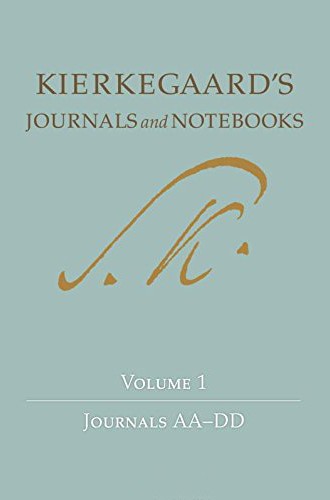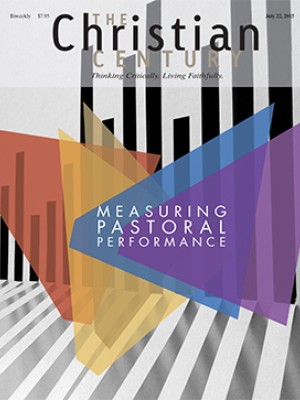Kierkegaard’s Journals and Notebooks
The preternaturally reflective Søren Kierkegaard (1813–1855) had his worries about reflection. He thought that speculation is often a means of evading choice, action, and faith. Nevertheless, when it comes to thinking about what it means to believe in or trust in God, there is no better conversation partner than the Danish author who considered himself not a philosopher, but a poet—or, as he once put it, “the best prose stylist in Denmark.” Kierkegaard was also a depth psychologist with epiphanies about the inner life rivaling those of Augustine, Dostoevsky, and Freud. This we know from his psychological masterworks, The Concept of Anxiety and The Sickness unto Death.
And yet there is another window into Kierkegaard’s mind besides his published works. Like Tolstoy, Thoreau, and Dostoevsky, Kierkegaard was a prolific diarist, and he left behind an immense treasure trove of diaries, drafts, notes, and miscellany. Kierkegaard intended that large portions of his journals would be published, but there were notes, jottings, and even doodles that he did not foresee coming before the public eye. After Kierkegaard’s death, the work of gathering, organizing, and editing his unpublished papers passed in stages from his nephew to his brother and finally to a former newspaper editor, Hans Peter Barfod. Barfod dove into the project, hoping, as he passionately put it, to expose “the colossal and clandestine workshop of the soul, enabling us to hear the hammering and banging, the relentless, unremitting, strenuous and impassioned labor” and to become “the eyewitness and earwitness of this thinker, this melancholy hermit, in his daily suffering and struggle in the service of self-denial and of the ideal.”
Read our latest issue or browse back issues.
But the work of opening up the thrumming factory of Kierkegaard’s inner world became overwhelming for Barfod, and he eventually passed the editorship on to the Kierkegaard devotee Hermann Gottsched. Two volumes of the papers were published in 1869 and 1872, but the editing of these early renditions was less than judicious. The material was arranged chronologically, and during production of the published volumes pages from the original were cut up and lost.
Over the decades multiple English translations of selections from the journals and papers have appeared, most notably Alexander Dru’s The Journals of Søren Kierkegaard (1938) and Howard Hong and Edna Hong’s comprehensive, multivolume Søren Kierkegaard’s Journals and Papers (1967–1978). In 1996, the philosopher Alastair Hannay put his 704-page Papers and Journals: A Selection into circulation.
When I first learned that there was a plan to translate the complete Danish edition of Kierkegaard’s journals and notebooks, I was dubious, thinking that the excellent compilations already in print would suffice. As I saw it, scholars who were interested in following the lineaments of Kierkegaard’s thoughts that closely would just learn Danish. I was dead wrong. It would take years for non–Danish speakers to reach the level of proficiency necessary to make fluid use of these supremely complicated and illuminating texts.
The Princeton University edition of Kierkegaard’s Journals and Notebooks is thus a mitzvah both to the scholarly world and to nonscholars with an ardent desire to understand the Mozart of the spirit that is Søren Kierkegaard. The seventh of the 11 volumes of the English translation became available in 2014. Like the other volumes, it is an aesthetic and scholarly masterpiece. The editors spare no effort in bringing the manuscripts back to their 1855 configuration. In the introduction to volume one the editors write that “Kierkegaard’s usual custom with his journals and notebooks was to crease the pages lengthwise (vertically) so that each page had an inner column for the main text and a somewhat narrower outer column for subsequent reflections and additions. In this way, further reflections could be—and very often were—added later, sometimes much later.” This format has been retained, with the main texts and marginalia on one side of each page and, on the other, extensive and highly detailed footnotes to both main and subordinate scribblings.
Kierkegaard was an inveterate walker, and reading the journals is akin to taking a stroll with him as he verbally dances out various theological gems and penetrating observations of society. Then, as we round the corner, the topic of conversation might shift to pedestrian worries about his financial and living situation. The supernal and earthly concerns are all mixed together in these journals, just as they were teeming behind his brows.
The latest volume in the series is replete with Kierkegaard’s reactions to the transition to democracy in Denmark in 1848. No Thomas Jefferson, Kierkegaard quips that “voting is, of course, the productive force in connection with the deification of the numerical.” Or again: “With this unending voting, ethical concepts, too, will finally vanish from the democracy.”
In these pages, one can also feel the rumblings of Kierkegaard’s impending attack on Christendom. But there is also the personal. In 1850, Kierkegaard was, as usual, going back and forth about continuing to write. He told himself:
If I had had not fortune whatever, fundamentally I would have been better off, I think, because then I would have had to devote all my powers to earn a living and would have had no qualms of conscience to the effect that I was not allowed to do so.
But now, when I can understand how extraordinary much has been entrusted to me, how much good I am doing—it seems to me that inasmuch as I still do have money, I ought to remain at my post.
The texts contain a staggering cornucopia of notes that are helpful in contextualizing and clarifying Kierkegaard’s remarks. For instance, in one entry Kierkegaard refers to “the old edifying writings.” What might they be? Voilà—there we have it—“Edifying literature, i.e., writings for private devotional use and spiritual guidance, constituted a significant portion of religious literature in the 17th and well into the 18th century.” And then the note goes on to list some of Kierkegaard’s favorite edifying authors. Nothing is a matter of indifference to the team of scribes who have put the Humpty Dumpty of Kierkegaard’s uncollected thoughts back together again.
As for the value of Kierkegaard’s musings: one could almost close one’s eyes, stick an index finger into the text, and find a plum. Like this one:
It is my conviction (and I have never understood Xnty differently) that as rigorous as it is, it is also lenient.
It is not given to everyone, and therefore neither is it unconditionally required of everyone, that he in the most rigorous sense must live in poverty and humiliation. But he must be honest, he must frankly confess that such a thing is too high for him, and then rejoice as a child under lenient conditions, since ultimately grace is nonetheless the same for everyone.
For all of his lyricism, many of Kierkegaard’s works project themselves as an impenetrable fortress of abstractions. These magnificently translated journals are a tunnel beneath the moat of that fortress. They capture the unpackaged and unbuttoned Kierkegaard and thus provide a stimulus to anyone intent on understanding a religious author who could well be reckoned a Luther of Lutheranism.







